The Yamaha F115 weight depends on the model and shaft length, but it remains one of the lightest 115-horsepower outboards available:
- Yamaha F115 4 stroke weight (20-inch shaft): 377 lbs (171 kg)
- Yamaha F115 4 stroke weight (25-inch shaft): 386 lbs (175 kg)
The weight of a Yamaha F115 four-stroke makes it a preferred choice for mid-sized boats, anglers, and water sports enthusiasts, as it offers a balance of fuel efficiency, power, and maneuverability. Compared to heavier alternatives, this lightweight design enhances acceleration and handling while reducing fuel consumption.
The Yamaha F115 is a great 4-stroke outboard motor known for its lightweight design and powerful performance. The Yamaha F115 4-stroke weight ranges from 377 lbs (171 kg) to 386 lbs (175 kg), making it one of the lightest options in its class. This lightweight build improves handling, acceleration, and fuel efficiency, making it a top choice for mid-sized boats.
This is due to the outboard’s 1.8-liter displacement and DOHC/SOHC designs with four valves per cylinder, providing a lighter weight and extraordinary volumetric efficiency. This option is the perfect choice for a mid-sized craft, with lots of bang for your buck. Originally put on the market in 1999, the Yamaha F115 has received a number of upgrades since then, improving the basic design with modern features. This suits both water sports enthusiasts and anglers alike.
Like all outboard motors, Yamaha 115 4-stroke outboard problems are bound to occur through heavy usage and aging of components. Despite its high performance, regular maintenance and servicing are required to keep this outboard motor in the water and out of the shop.
In this article, we will take a look at five of the most common Yamaha 115 4-stroke problems, including:
- Faulty head gasket
- Bad fuel pump
- Clogged fuel injectors
- Clogged VST filter
- Trim and tilt switch issues
1. Faulty Head Gasket
Over the lifetime of your Yamaha F115, the head gasket will eventually wear down and fail, causing severe damage to your engine if not addressed.
For novice boaters, the head gasket serves as an important component in the performance and lifespan of your Yamaha F115. Head gaskets are made of a non-porous material located between the cylinder block and the cylinder head (where your spark plugs are screwed in). Its purpose is to seal these parts together to both withstand the compression from the engine while also enabling water to flow between the block and the head for temperature regulation.
Over time, the head gasket of your Yamaha F115 is regularly exposed to a number of elements that reduce its integrity, such as salt water, heat, fuel, and other substances. Once a head gasket fails, water and other contaminants will enter your engine. That leads to poor performance (ie. engine bogging down, excessive vibrations), engine damage, and eventually failure - plus a hefty repair bill.
When it comes to Yamaha 115 4 stroke problems, replacing the head gasket should be a priority every 4 years of service, or sooner if usage exceeds the average boater (50 hours per season, or 200 hours for 4 years). There are also a number of other signs to pay attention to that may indicate a faulty head gasket:
- Idle runs too slow/rough
- Low pressure in the cylinders (use a compression test to find out)
- Holes and debris in and around the head gasket
2. Bad Fuel Pump
One of the most common Yamaha 115 4-stroke problems is a bad fuel pump.
There are plenty of signs that you can recognize when a fuel pump has gone bad for your Yamaha F115:
- When a fuel pump malfunctions, the engine may bog down when you throttle up or at idle.
- The fuel pump is responsible for bringing gas from your fuel tank to your engine. Any malfunction can therefore impact consistent performance like RPMs, top speeds, and gas efficiency.
- You may experience Yamaha 115 4-stroke starting problems that often lead to over-priming the engine.
- And when the fuel pump finally gives out, your motor is essentially dead in the water until it is fixed.
Luckily, replacement of a bad fuel pump on a Yamaha F115 is a simple repair. It's also relatively inexpensive when compared to other necessary engine repairs.

Tips for Preventing a Bad Fuel Pump
There are a number of things you can do to keep your fuel pump in decent shape:
- Never let the gas tank hit empty. Instead, you should view ¼ full as empty
- Use low-ethanol gas when possible
- Add fuel stabilizer when refueling and winterizing
- Regularly clean out your gas tanks to prevent contaminants from being introduced into your engine and strain the pump
- Drain your gas tanks and hoses during the winter
- Regularly clean and replace all fuel filters, including the VST filter (see below)
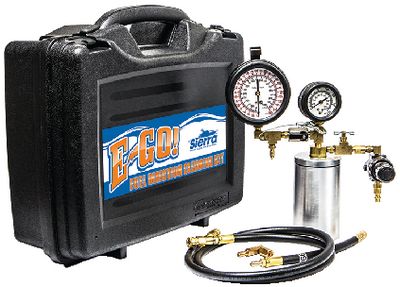
3. Clogged Fuel Injectors
Many Yamaha 115 4-stroke problems such as starting issues and misfires can come from clogged fuel injectors.
Fuel injectors can become clogged due to carbon build-up that prevents a smooth distribution of fuel. When this occurs, your outboard may misfire, vibrate excessively, and bog down during idle or when throttle is applied.
As part of keeping your Yamaha 115 4-stroke problems to a minimum, cleaning your outboard fuel injectors with fuel injector cleaner will keep your motor performing at its best.
Repairing Clogged Fuel Injectors
To give you an idea of what tasks, tools, and equipment you will need with a DIY project, here’s what’s involved when cleaning your fuel injectors:
- First, you’ll need to remove the fuel injectors off of the engine, which includes the fuel rails. (Note: There are other methods of cleaning your fuel injectors that enable you to perform this repair while the fuel injectors remain on the engine).
- Carefully remove the rubber O-rings and gaskets from each fuel injector.
- Once removed, manually clean the injectors with a rag and fuel injector cleaner to remove any surface debris.
- Next, you will take a length of fuel hose and clamp the fuel injector to one side of the hose.
- Fill the fuel hose with an ample amount of fuel injector cleaner.
- On the other side of the hose, you will clamp it to an air compressor to create an imitation of the pressure in the engine and force the fuel injector cleaner through the injector’s nozzle. (Note: There is specialized equipment for this task)
- Supply power to the injector to allow the air and fuel injector cleaner to move through the nozzle using a battery and a pair of spade connectors
- Apply air pressure to the hose and quickly tap on the battery to send voltage to the fuel injector, opening and closing it (to simulate its regular function). This enables the fuel injector cleaner to flow through the fuel injector.
- Repeat the process until each of the fuel injectors has been cleaned.
As you can see, this can be a DIY project as a quick fix for those with the tools and the time, but it’s recommended to bring your fuel injectors in for a professional cleaning. Boat mechanics have specialized tools and can perform a more thorough cleaning. However, this is a common repair before and after boating seasons, so many mechanics will require you to leave the injectors with them for a few weeks in order to clean them.
4. Clogged VST Filter
Almost equally important for avoiding Yamaha 115 4-stroke problems to your fuel system is regularly replacing your VST filters. Your VST filter is responsible for keeping contaminants from entering your Yamaha outboard’s Vapor Separator Tank (VST). This is attached to the fuel pump - see above.
Just before the gas is pressurized into the fuel injection rails, the VST is the last line of defense against contaminants before reaching the fuel injectors. This means that contaminants that aren’t filtered out by other fuel filters of your engine reach the VST. That makes it a prime spot for deposits to gum up your engine. Sometimes, changing the other fuel filters may not have an effect without this essential maintenance.
There are plenty of kits to help clean and/or replace your VST filter for proper fuel system maintenance. If this maintenance isn’t performed regularly, you may have to perform a more time-intensive and expensive repair that involves cleaning out the Vapor Separator Tank - or worse, installing a replacement altogether.
5. Trim and Tilt Problems
Are you having problems with the trim and tilt switch of your Yamaha F115?
Trim and tilt problems are common, but the Yamaha F115 weight (377–386 lbs) plays a role in how well your boat balances on the water. A lightweight outboard like the Yamaha F115 4-stroke can help optimize trim adjustments, improving fuel efficiency and maneuverability.
Trim and tilt involve how well your boat is propelled through the water by the angle of the propeller shaft relative to the boat. A faulty trim and tilt switch can prevent you from the fine-tuning (trim) and dramatic changes (tilt) needed for optimal performance of your Yamaha F115, including:
- Poor gas efficiency due to friction/drag of the water
- Lower RPMs, acceleration, and overall top speed
- Less accurate control during operation
- Inability to raise the motor for storage, servicing, and/or removal
Because of the weight of a Yamaha F115 four-stroke, this outboard motor naturally offers better fuel efficiency compared to heavier models. However, if the trim and tilt system malfunctions, fuel economy can still be affected, as improper angles can increase drag and resistance.
Luckily, you can avoid these problems by swapping out the trim and tilt switch as needed. However, keep in mind that a faulty trim/tilt switch can be a sign of some other issues, such as low battery, electrical shorts, malfunctioning hydraulic motors, and more.
Is the Yamaha F115 4-stroke heavier than other outboards?
No, the Yamaha F115 weight is lighter than many comparable 115HP outboards, weighing 377–386 lbs depending on shaft length. This makes it an excellent choice for improved fuel efficiency and handling.

* * *
As you can see, there are many reasons why you may be experiencing Yamaha 115 4-stroke problems. If you’re looking to get to work on maintaining your Yamaha F115 4-stroke problems, Yamaha has plenty of manuals for this outboard (and nearly any other equipment they produce). And to make it a cinch, PartsVu’s Yamaha F115 20-hour maintenance kits and Yamaha F115 100-hour maintenance kits help to deliver on this reliability year after year.


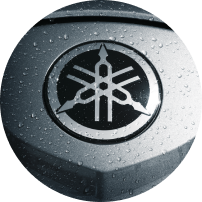
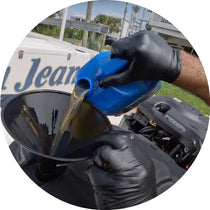
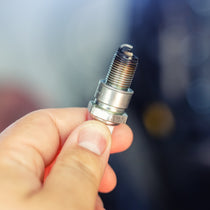
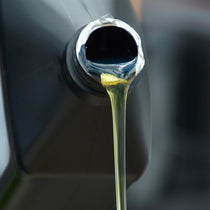

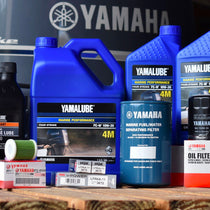


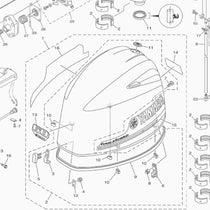






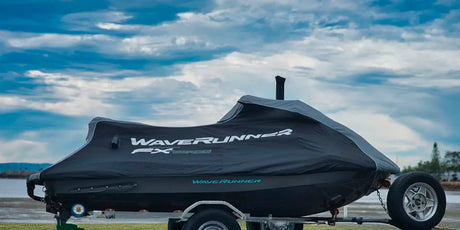




3 comments
I have a ‘99 Yamaha 115. It starts fine and runs, idles or cruses fine, but after a couple minutes it bogs down and runs rough until I squeeze the primer bubble on the gas line, after two squeezes it picks back up and run fine, for another couple minutes. I’ve changed the fuel water filter, and the small filter on the back of motor with no improvement. Being as it runs fine when it has fuel, could it be the pickup pump on the back of motor, or high pressure pump?
———
PartsVu replied:
Hi Bob, thanks for reaching out and sharing the details of your issue.
Based on your description—where the engine bogs down after a few minutes but recovers after squeezing the primer bulb—it does sound like your engine is starving for fuel. Since you’ve already replaced the fuel/water separator and the small filter on the engine without improvement, the problem could point to one of the following:
1. Weak or failing low-pressure fuel pump (also called the lift pump). This is a common cause of the symptoms you’re describing. If it’s not maintaining proper fuel flow, the engine may bog down until you manually prime it. 2. Air leak in the fuel line—a cracked fuel line, faulty primer bulb, or loose clamps can allow air to enter the system, causing similar issues. 3. Fuel pickup or anti-siphon valve restriction at the fuel tank—these components can sometimes get clogged and restrict fuel flow, especially under higher loads. It’s less likely to be the high-pressure fuel pump right away, since those failures usually cause more severe or continuous running issues, but it can’t be ruled out entirely. That said, we recommend having your motor inspected by a Yamaha-certified mechanic to properly diagnose the issue. While we’re happy to provide general guidance, we’re not certified mechanics and it’s always best to have a professional take a closer look. If you need help locating parts, diagrams, or a service manual in the meantime, feel free to reach out—we’re happy to assist!Best Regards
Markine
A friend of mine has a 2018 115 Yamaha outboard. He’s trouble shooted everything and can’t find a solution. The issue is when throttling up , the engine bogs down. What is the fix?
———
PartsVu replied:
When a 2018 Yamaha 115 outboard bogs down under throttle, it typically points to an issue in the fuel delivery, air intake, or ignition system. Since your friend has already done some troubleshooting, here’s a more targeted list of common causes and fixes:
Most Common Causes & Fixes
1. Clogged VST (Vapor Separator Tank) filter * Symptom: Engine bogs when under load. * Fix: Remove and inspect/clean or replace the VST filter. Also inspect the high-pressure fuel pump and check for water or debris in the tank. 2. Dirty or clogged fuel injectors * Symptom: Poor throttle response, bogging under acceleration. * Fix: Remove and clean injectors. Use a quality injector cleaner or have them flow tested by a shop. 3. Fuel pump issue (low pressure) * Symptom: Sufficient idle, bogs under load. * Fix: Check low-pressure fuel pump output. If weak, replace the pump. Check also for vacuum leaks or collapsing fuel lines. 4. Fuel line or anti-siphon valve restriction * Symptom: Bogging at higher RPMs due to fuel starvation. * Fix: Inspect and replace any soft or kinked fuel lines. Check/replace the anti-siphon valve at the fuel tank. 5. Bad or old fuel / water in fuel * Symptom: Engine may run at idle but bogs under load. * Fix: Drain fuel tank, replace with fresh ethanol-free fuel, replace fuel-water separator. 6. Dirty or failing spark plugs * Symptom: Misfiring or bogging. * Fix: Inspect, clean, or replace spark plugs. Check gap and signs of fouling. 7. Throttle position sensor (TPS) or ECU issue * Symptom: Poor throttle control, hesitation. * Fix: Use Yamaha diagnostic software or gauge to test the TPS and other sensors. Replace if faulty.Next Steps / Recommendations
Run a Yamaha Diagnostic System (YDS) scan to look for fault codes or sensor issues. * Test fuel pressure at both low and high sides. * Verify the engine is reaching proper operating temperature — a faulty thermostat can affect performance. * Check for air leaks in the intake system (loose hose clamps, cracked hoses).If your friend has already checked these and the issue persists, a Yamaha-certified tech with access to diagnostic tools would be the best next step. They can run live data tests and pinpoint issues more precisely.
Best Regards Markine
i have a 2022 115 yamaha v max with 88 hours on it .just got out of shop for fuel pump ,now its doing same thing.it was ideling and kinda back fired and quit now it wont start.same thing as before.bought this motor for reliability but not happy.its been in shop 5 times in 2 years ?my 2 stroke lasted 20 years .
———
PartsVu replied:
Hi Larry,
I can totally understand your frustration, especially after investing in a Yamaha V Max for reliability and having it in the shop so often. It’s disheartening to have a newer motor that’s giving you recurring issues like this. Given that the fuel pump was replaced and the problem persists, it sounds like there might be something deeper going on—like a possible fuel delivery issue, electrical connection, or maybe even a sensor malfunction. It’s worth getting a second opinion from a different shop if you haven’t already, just to rule out any underlying issues that might have been missed. Yamaha motors are usually pretty solid, but even with modern engines, things can sometimes go wrong, especially if the diagnostics don’t quite catch the root cause. I hope you get it figured out soon! 5 visits in 2 years is certainly not what you’d expect from a newer engine. Best of luck! Markine D